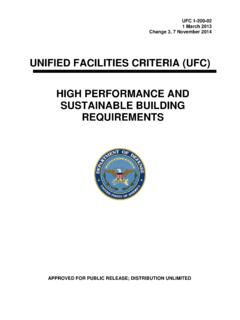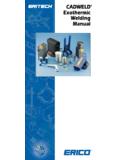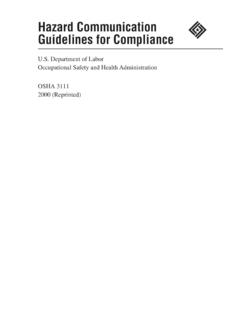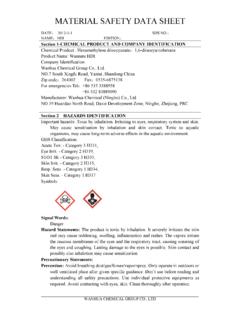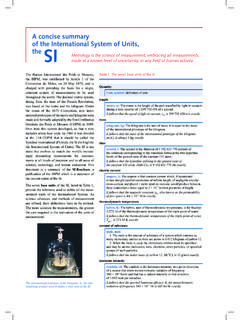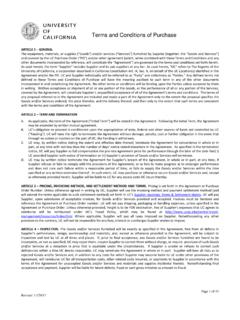Transcription of Ch 6 - Analyzing Direct Material Costs
1 Ch 6 - Analyzing Direct Material Costs - Chapter Introduction - Identifying Direct Material Costs For Analysis o - Identifying Material cost Elements o - Identifying Collateral Costs o - Identifying Related Costs o - Planning For Further Analysis - Analyzing Summary cost Estimates - Analyzing Detailed Quantity Estimates - Analyzing Unit cost Estimates - Recognizing Subcontract Pricing Responsibilities Chapter Introduction Direct Material Costs often account for more than half of total contract cost . This chapter will present points to consider when you develop a prenegotiation position on Direct Material Costs . Flowchart of Direct Material Costs Analysis: Identifying Direct Material Costs For Analysis This section will identify the types of cost that may be classified as Direct Material Costs and points to consider in planning for further analysis.
2 - Identifying Material cost Elements - Identifying Collateral Costs - Identifying Related Costs - Planning For Further Analysis Identifying Material cost Elements Material cost (FAR ). The cost of materials used to complete a contract normally includes more than just the cost of the materials that actually become part of the product. Costs typically include: Raw materials, parts, subassemblies, components, and manufacturing supplies that actually become part of the product; Collateral Costs , such as freight and insurance; and Material that cannot be used for its intended purpose ( , overruns, spoilage, and defective parts). Direct vs. Indirect Material cost (FAR and ). Each firm is responsible for determining whether a specific cost will be charged as a Direct cost or an indirect cost , and you will find that accounting and estimating treatment will vary from firm to firm.
3 This section describes the general practices that you can use to identify Direct Material Costs for analysis. Direct Material cost . A Direct Material cost is any Material cost that can be identified specifically with a final cost objective ( , a particular contract). o Material Costs identified specifically with a particular contract are Direct Costs of the contract and must be charged to that contract. o Material Costs must not be charged to a contract as a Direct cost if other Material Costs incurred for the same purpose in like circumstances have been charged as an indirect cost to that contract or any other contract. o All Material Costs specifically identified with other contracts are Direct Costs for those contracts and must not be charged to another contract directly or indirectly. Indirect Material cost . An indirect Material cost is any Material cost not directly identified with a single final cost objective, but identified with two or more final cost objectives or an intermediate cost objective.
4 For reasons of practicality, any Direct Material cost of minor dollar amount may be treated as an indirect cost if the accounting treatment: o Is consistently applied to all final objectives, and o Produces substantially the same results as treating the cost as a Direct cost . Accounting for Materials. The following table matches Material types with their most common accounting treatment. This table is only a general guide. Proper accounting treatment will vary with different acquisition environments and the specific accounting guidance adopted by the firm. Material Type* Description Accounting Treatment Raw MaterialsMaterials that require further processing Normally a Direct cost Parts Items which, when joined together with another item, are not normally subject to disassembly without destruction or impairment of use Normally a Direct cost but possibly an indirect cost if price is very small SubassembliesSelf-contained units of an assembly that can be removed, replaced, and repaired separately Normally a Direct cost Components Items which generally have the physical characteristics of relatively simple hardware items and which are listed in the specifications for an assembly, subassembly.
5 Or end item Normally a Direct cost Manufacturing Supplies Items of supply that are required by a manufacturing process or in support of manufacturing activities Normally an indirect cost * The Material types in this table are drawn from FAR (a), Material Costs . The terms reflect a manufacturing orientation. When Analyzing Material Costs proposed for services or construction, compare the proposed use of the materials with the definitions in this table for the most appropriate accounting treatment. Also, consider the general guidance offered on the previous page. Identifying Collateral Costs Collateral cost Accounting Treatment (FAR (a)). Collateral Costs are expenses associated with getting materials into the offeror's plant. Inbound transportation and intransit insurance are two common examples. These Costs may either be treated as Direct Costs or indirect Costs depending on the guidelines established by the firm.
6 If they are treated as Direct Costs , they are normally tracked with the cost of the associated Material item. As you perform your cost analysis, make sure that the proposed treatment is consistent with the firm's treatment of similar Costs under similar circumstances. Also make sure that the offeror is not charging twice for the same transportation and insurance cost . The cognizant Government auditor will be able to assist you in determining whether the proposal correctly recognizes transportation Costs consistent with the offeror's prescribed accounting practices. For example: When an item is bought destination the price normally includes delivery to a point designated by the buyer. Unless some type of special handling is required, the buyer should not have any additional transportation or in-transit insurance Costs . Inbound Transportation (FAR (a) and ).
7 Inbound transportation cost , also known as freight-in expense, is the cost of transporting Material to the place of contract performance. It may be the cost of transportation from the supplier's plant or some intermediate shipping point. This cost is allowable as long as it is reasonable, but remember that this cost should be included in any price quoted destination. Intransit Insurance (FAR , (a), and ). The intransit insurance expense related to Material is the cost of insurance for inbound Material . Any Costs of insurance required or approved by the Government and maintained by the contractor under a Government contract are allowable. The cost of intransit insurance not specifically required or approved under a Government contract must meet appropriate FAR and CAS requirements. The most basic requirements are that the types and extent of insurance must follow sound business practice, and the rates and premiums must be reasonable.
8 Identifying Related Costs Accounting for Related Materials (FAR (b)). Identify estimates of excess materials that the offeror proposes to purchase to assure that sufficient Material is available for production of the item. Estimates may include Costs related to Material overruns, scrap, spoilage, or defective parts. Some offerors will develop a single estimate which encompasses all of these Costs . When a single estimate is used, it is usually referred to as scrap. Other offerors will develop separate estimates for several of the different types of excess Material cost . When a firm develops separate estimates, make sure that each type of excess Material cost is clearly defined and that the same Costs do not appear in different estimates. Estimates of these Costs are usually developed using a cost estimating relationship (CER) -- a relationship between the cost and some independent variable related to a parameter of the item or service being acquired or a related contract cost .
9 The proposal and related documentation must provide adequate analysis and statistical data to identify and support any CER used in estimating Direct Material cost . Remember that Material overruns, scrap, spoilage, or defective parts not used on the proposed contract will still have residual value. The offeror might use this Material in producing other products, or sell it for reclamation or reprocessing. As a result, the estimated contract cost must be adjusted to consider that residual value. The offeror might adjust the proposal by subtracting the estimated residual value from the estimated Direct Material cost . More commonly, offerors will estimate the residual value of such Material for all contracts for the year and then subtract that estimated amount from an appropriate overhead account. Each contract proposal estimate is then reduced by use of the lower overhead rate.
10 Overruns. Simply stated, overruns are the purchase or production of more units than are required by the job. For example: A minimum order quantity requirement is a common example. An assembly requires 25 units of a special fastener that can only be bought in quantities of 100. If the fastener can only be used on the one contract, you should expect to pay for all 100 units. On the other hand, if the fastener has general application to other items produced by the firm, you should expect to only pay only for the units used on your contract. Scrap. Scrap is Material that is no longer usable for the purpose for which it was originally purchased. For example: A casting may require machining prior to its use as part of a larger assembly. The Material removed during the machining process is scrap. A sheet of metal may have a variety of shapes cut from it.



